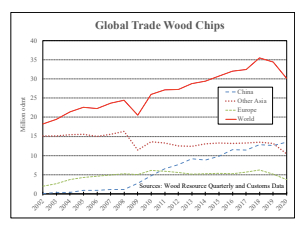Global Trade Of Wood Chips Increased By Almost 50% From 2009 To 2020, Driven By Substantial Demand By Chinese Pulpmills
Global trade of wood chips, which are mainly used by pulpmills, grew from about 21 million tons in 2009 to an all-time high of 35 million tons in 2018. Subsequently, trade declined for two consecutive years to reach just over 30 million tons in 2020. Significant investments in new pulp capacity in China combined with a lack of domestic wood fiber have been driving practically all of the global increase in wood chip trade during the past decade.
Outside of China, the trade of wood chips has been relatively stable the past ten years, ranging between 20-21 million tons annually, except for 2020, when total shipments fell to just under 17 million tons (see chart).

Hardwood chip imports to China reached a new record high of 13.2 million odmt in 2020. This was a 7% increase from the previous year and continued an unprecedented upward trend that started in 2008 when China imported only one million odmt. Although China overtook Japan as the largest hardwood chip importer five years ago, 2020 was the first year when over 50% of the world’s traded hardwood chips landed at Chinese ports to feed large, newly built pulpmills in the country.
There were some dramatic changes in Chinese fiber sourcing during 2020, with Australia’s shipments falling almost 30% y-o-y and the largest supplier, Vietnam, increasing its sales by 25%. Over the past two years, Chinese pulpmills shifted from importing higher yield fiber quality (HYF) from regions such as Australia, Chile, and Brazil towards lower yield fiber (LYF), from places like Vietnam, Thailand, and Malaysia. The HYF chips would typically be Eucalyptus chips with higher density, often requiring less chemicals in the pulping process.
When the investments in large-scale pulp mills took off in 2008, the preferred wood fiber was predominantly lower quality and lower cost, including Acacia wood chips from Vietnam, Thailand, and Indonesia. Nevertheless, that started to change in 2013-2014 when pulpmills saw the cost and quality benefits of using more high-quality hardwood chips such as Eucalyptus Nitens and Eucalyptus Globulus from Australia and Chile. From 2012 to 2017, the HYF share of total imports dramatically increased from 11% to 47% of the total import volume. However, in 2018, this five-year rise in market share leveled off and fell during 2019 and 2020 to average only 33% in the 4Q/20.
With the supply of hardwood fiber becoming tighter around the Pacific Rim, the fiber sourcing by Chinese pulpmills will likely continue to evolve, including the possibility of new regions coming into play.
Are you interested in worldwide wood products market information? The Wood Resource Quarterly (WRQ) is a 70-page report established in 1988 and has subscribers in over 30 countries. The publication tracks prices for sawlog, pulpwood, lumber & pellets and reports on trade and wood market developments in most key regions worldwide.


 Seafood New Zealand: Seafood Situation Saved By A Sausage: New Plymouth Locals Innovate, Using Crayfish Bait
Seafood New Zealand: Seafood Situation Saved By A Sausage: New Plymouth Locals Innovate, Using Crayfish Bait Takeovers Panel: Takeovers Panel Convenes Meeting To Inquire Into The Acquisition Of Shares In NZME Limited
Takeovers Panel: Takeovers Panel Convenes Meeting To Inquire Into The Acquisition Of Shares In NZME Limited WorkSafe NZ: Conveyor Belt Death-Trap Was A Danger In Plain Sight
WorkSafe NZ: Conveyor Belt Death-Trap Was A Danger In Plain Sight Commerce Commission: 2degrees Fined $325,000 For Misleading Claims About ‘Free’ Aussie Business Roaming
Commerce Commission: 2degrees Fined $325,000 For Misleading Claims About ‘Free’ Aussie Business Roaming  Natural Hazards Commission: Hub Launched To Empower Architects And Engineers To Build Above Code
Natural Hazards Commission: Hub Launched To Empower Architects And Engineers To Build Above Code Harmony Energy: Ceremony Heralds Start Of Construction On New Zealand’s Largest Solar Farm Project
Harmony Energy: Ceremony Heralds Start Of Construction On New Zealand’s Largest Solar Farm Project



